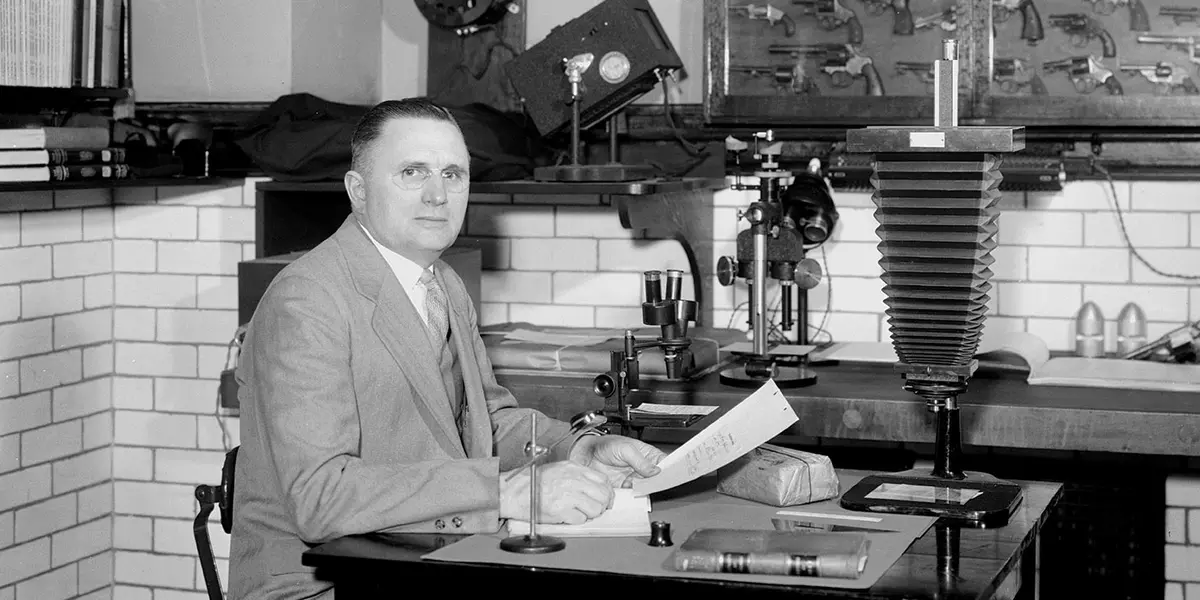
Wilmer Souder in his laboratory at the National Bureau of Standards in Washington, D.C., April 11, 1935.
Who Was Detective X?
In the gangster era of Prohibition and the Great Depression, a physicist at the National Bureau of Standards, now NIST, brought modern ideas to the then-emerging field of forensic science.
It was called the Trial of the Century, and it ended on February 13, 1935. On that winter night, the Hunterdon County Courthouse in Flemington, New Jersey, was surrounded by thousands of people awaiting the verdict. When it came, the crowd jeered. The defendant, Bruno Richard Hauptmann, was found guilty of kidnapping and killing the 20-month-old son of aviator Charles Lindbergh. Hauptmann would die in the electric chair the following year.
The ransom notes helped seal Hauptmann’s fate. Eight experts testified that the handwriting on the notes matched Hauptmann’s. In the media frenzy that was the Lindbergh trial, one of those experts made a point of avoiding the spotlight, something he did throughout his long career. Years later, when he was nearing retirement, a profile in Reader’s Digest would refer to him as Detective X.
His name was Wilmer Souder. A physicist at the National Bureau of Standards, now known as the National Institute of Standards and Technology (NIST), Souder played an important role in the early days of forensic science. He helped send countless murderers, bootleggers, gangsters and thieves to prison, and he kept such a low profile partly out of concern for his and his family’s safety. Perhaps as a result, he was not long remembered for his forensic work, and his influence on the developing field of forensic science was not as great as it might have been.
But this story is about more than a partly forgotten historical figure. It’s also about the history of science, and the fact that progress usually does not happen in a straight line. Souder brought precision measurement and rigorous standards to the emerging field of forensic science. In doing so, he confronted issues that modern forensic science is still grappling with today.
Now, a scientist and a historian are bringing Souder’s story to light. But their efforts have been impeded not only by a scarcity of historical records—something many researchers must contend with—but also by the fact that Souder had diligently obscured his own role.
The Search Begins
The search started in late 2014, when Kristen Frederick-Frost, then working as curator of the NIST Museum, was planning a display of objects related to the history of forensic science. Frederick-Frost, who earned a Ph.D. in physics before obtaining a master’s degree in the history of science, is fascinated by historical artifacts. Often, when she finds one, she manages to convey both spontaneous excitement and scholarly seriousness at the same time.
Frederick-Frost knew of Souder’s work in forensic science from a few brief mentions in the agency’s official history, and she hoped that the NIST archive might include a Souder-related artifact or two for her display. So, she put on a thick sweater she keeps at her desk and headed down to the agency’s archive, which is really just a room in the basement filled with shelves and kept cold to preserve the collection.
On one of those shelves was a box containing much more than she was expecting to find. In it were nine old notebooks, each bound in green fabric and filled with Souder’s barely legible script.
“It took me about ten minutes of reading before I realized how big a deal this was,” Frederick-Frost said.
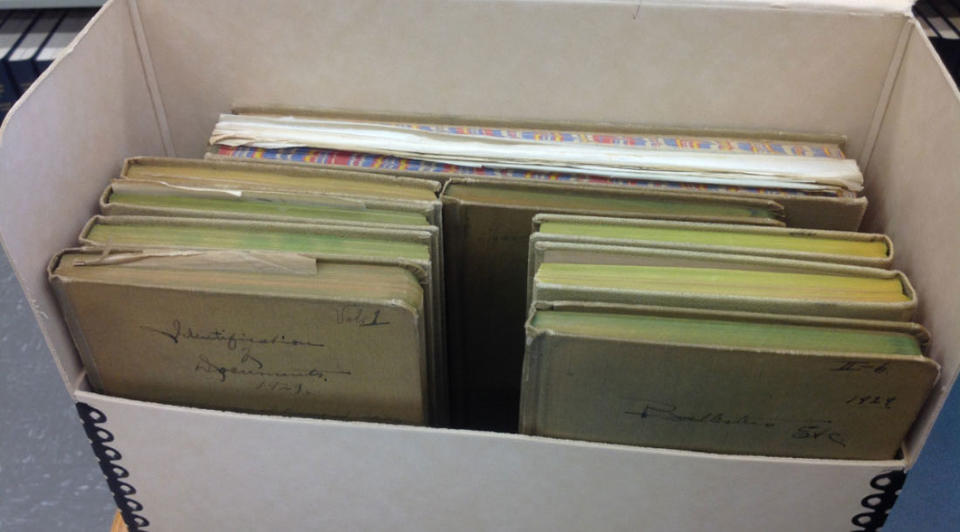
The nine notebooks of Wilmer Souder that Kristen Frederick-Frost found in the NIST archive. Read through high-resolution scans of all the pages of these notebooks in the NIST Digital Archive.
At around the same time, a NIST scientist whom Frederick-Frost had not yet met was also digging into Souder’s history. John Butler, like Souder before him, is an important figure in the history of forensic science. As a Ph.D. student in the 1990s, he developed techniques for analyzing DNA that are now standard practice in crime labs around the world.
Butler, a father of six, usually walks the less than two miles from his home to the NIST campus in suburban Gaithersburg, Maryland. He no longer works in the lab. These days, Butler plays a leading role in a NIST effort to strengthen the scientific foundation of forensics, and he is vice-chair of a federal advisory committee, the National Commission on Forensic Science. Butler’s goal, and that of the larger effort of which he is a part, is to strengthen forensic science in ways that ensure criminals are brought to justice and innocent people do not end up behind bars.
“It took me about ten minutes of reading before I realized how big a deal this was.”
During college, Butler had a summer internship at the National Archives, so he’s a bit of a history buff. If NIST were going to try to change the way forensic science is practiced today, Butler thought, it would be wise to learn from history. Butler also knew just a bit of Souder from the agency’s official history, and he started searching for Souder’s scientific publications.
“I had no idea how big a role Souder played,” Butler said.
A mutual colleague told Frederick-Frost about Butler. She called him, and within an hour Butler was poring over the notebooks and sharing what he had learned so far.
Trained by the Best
Souder, they would later learn, grew up on a farm in Indiana and worked briefly as a schoolteacher before earning a master’s degree in physics. He started working at the National Bureau of Standards in 1911. He must have shown considerable promise because he left two years later for the University of Chicago, then home to perhaps the top physics department in the United States. That department included Albert Michelson, who had won the Nobel Prize in Physics in 1907 for inventing optical instruments that could measure things very precisely. The Michelson interferometer, for instance, could measure distances of less than one micrometer, or one-millionth of a meter.
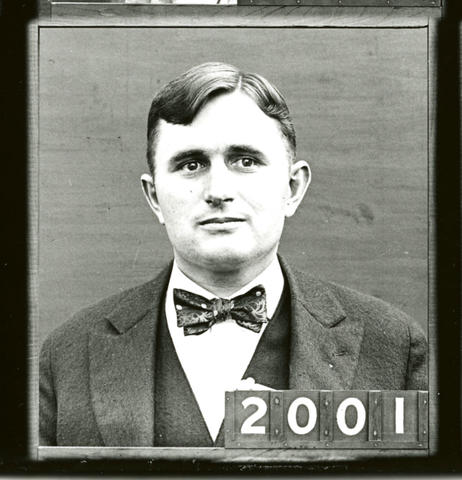
Wilmer Souder’s 1918 National Bureau of Standards personnel photo.
That department was also home to Robert Millikan, who would win the Nobel Prize in Physics in 1923 for his work on the photoelectric effect. Souder studied under Millikan and conducted many experiments on that same subject, though most of Souder’s research papers did not list him as first author. That honor, in keeping with a tradition that many graduate students are still familiar with today, went to Millikan.
Soon after receiving his Ph.D. in 1916, Souder returned to the National Bureau of Standards, where he made a name for himself by studying the physical properties of dental fillings, including how different amalgams expanded or contracted as they dried or changed temperature. Perhaps drawing on his doctoral training, he used an interferometer to measure these changes with great precision.
This work may seem less exciting than forensic science, but it was of great interest to the U.S. Army, whose soldiers required dental care. Although Souder is not well-remembered for his work in forensics, one of the most prestigious honors in the field of dental research is named for him: the Wilmer Souder Award.
The mild-mannered expert on dental fillings would soon develop a sideline in forensic science. In those days, federal agencies had not yet set up crime laboratories, so when they had evidence to analyze, they turned to the National Bureau of Standards for help. Forensic science is largely a matter of metrology—the science of measurement—and that fell squarely within the remit of the bureau. And within the bureau, who better to make extremely precise measurements of physical evidence than the University of Chicago-trained physicist?
When law enforcement agents brought evidence to him, Souder logged its receipt in a notebook. Among those notebooks were the nine that Frederick-Frost would find, almost a century later, in the NIST archive.
Butler spent his off-hours during the summer of 2015 filling a spreadsheet with dates, case numbers, and other data from the notebooks. He found that from 1929 until 1954, Souder worked on 838 cases, including almost 100 for the Department of Justice, which then included the Bureau of Prohibition as well as the FBI. He also worked on almost 300 cases for the Treasury Department, which often investigated mobsters for tax evasion—most famously, Al Capone, though no evidence has emerged that Souder worked on that case.
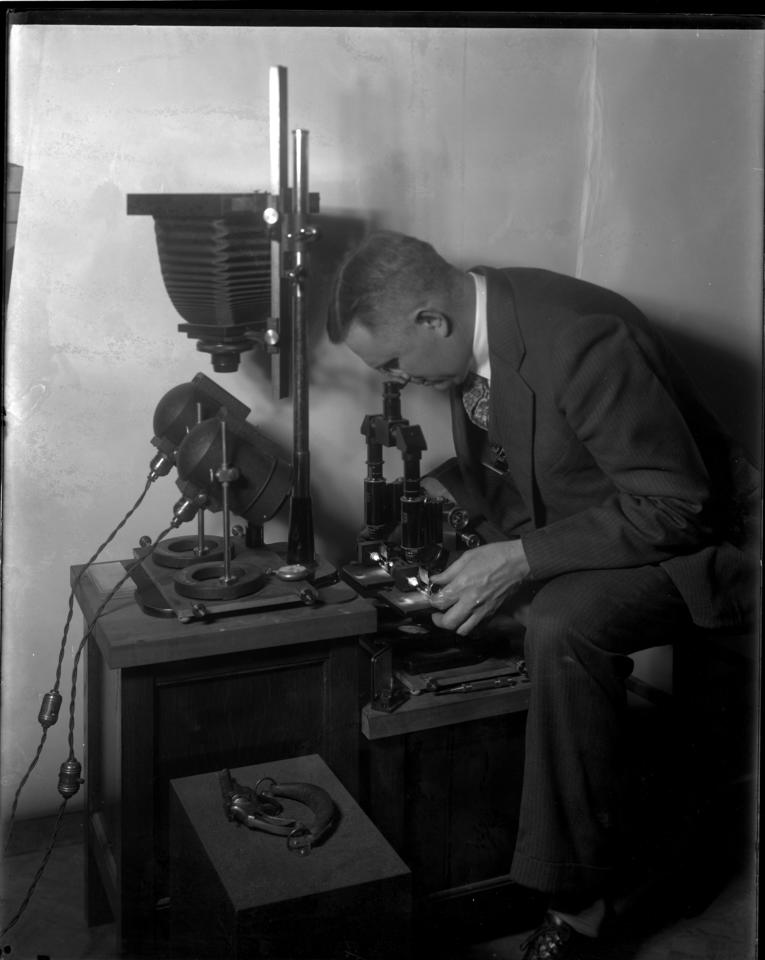
Wilmer Souder using an early comparison microscope to compare the rifling marks left on two bullets. By comparing these microscopic marks, a forensic examiner can assess whether or not they were fired from the same gun. This technique for comparing bullets is still used today in much the same way.
Most of the cases Souder worked on came from federal agencies. But there was at least one exception. On May 9, 1932, a Lieutenant R. A. Snook of the New Jersey State Police met with Souder at the bureau’s labs in Washington, D.C. Snook was the chief investigator in the Lindbergh case, and he brought with him the original ransom notes for Souder to photograph and analyze.
A few days later, Snook filed a report of this meeting with his police agency. “Dr. Souder explained that arrangements had been made for the work to be kept strictly confidential,” the report said. “The case was to be known to the Bureau of Standards as the Adamson case,” a fictitious name that Souder invented to throw busybodies off the trail.
The report went on to say that when Souder introduced Snook to people at the bureau, he introduced him as, “Mr. Martin, from New York.”
The Chicago Daily Tribune reported Souder’s involvement later that month, so in the Lindbergh case, at least, the information didn’t take long to leak out. But Souder’s notebooks are full of obscure references.
“Who knows what other famous cases he worked on,” Butler said.
On September 6, 1932, Souder must have been working on the Lindbergh case. His notebook entry for that day says, “see Adamson Volume.” Butler and Frederick-Frost searched everywhere they could think of for the Adamson volume. “I was obsessed with finding it,” Frederick-Frost said.
So far, at least, they haven’t.
The National Archives
Their next big break came later that year, when Frederick-Frost was searching through binders full of old archive transfer records at NIST. In one of them, she found a half-century-old transfer slip that documented a shipment to the National Archives containing more than 10,000 glass plate negatives. Other shipments contained detailed reports of laboratory test results. At least some of these photographs and reports, she was sure, would be from Souder’s lab.
She and Butler visited the National Archives in College Park, Maryland, several times in late 2015. Unfortunately, they learned that detailed reports related to identification of handwriting, typewriting and bullets—these were Souder’s areas of expertise—had been discarded in April 1944, presumably to make room in the collection for new material. But the glass plate negatives were there, and an archivist named William Wade gamely assisted by hoisting and carting heavy boxes full of those plates to the viewing area.
“We were at the end of a long day and I said, ‘Billy I have just one more pull, I’m sorry,’” Frederick-Frost said. He came back with a box that looked different from the others. When new material arrives at the facility, archivists repackage it in preservation-quality boxes. This was an old cardboard box that looked as if it had not been opened for decades.
Butler and Frederick-Frost, wearing white cotton art-handling gloves, opened the box. It was stuffed with shredded newsprint. Pushing that aside, they dug out two smaller boxes sealed with black tape. Scribbled across the top of those, in the same penciled handwriting that fills Souder’s nine notebooks, they saw the words, “Baby Lindbergh Kidnapping Case.”
“We were ecstatic,” Frederick-Frost said.
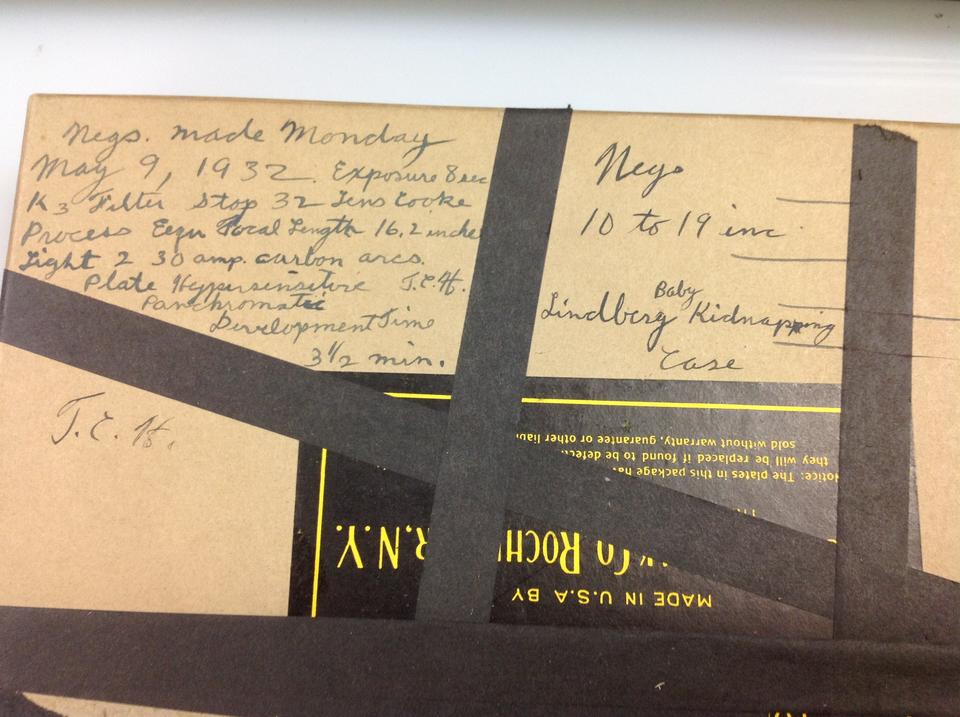
One of two boxes that John Butler and Kristen Frederick-Frost found at the National Archives containing glass plate negatives of ransom notes from the Lindbergh kidnapping case.
Opening the smaller boxes, they found glass plate negatives, produced during Lieutenant Snook’s May 9, 1932, visit to the National Bureau of Standards, of the handwritten ransom notes demanding money—some demanded $50,000, others $70,000— for the safe return of Charles Lindbergh Jr.
Souder analyzed the handwriting in those notes and testified at trial that the handwriting was Hauptmann’s. Prosecutors presented much other evidence as well, but Souder’s testimony did help send Hauptmann to the electric chair. Was his analysis of the evidence reliable?
In recent years, many forensic methods have come under increased scrutiny. A 2009 report from the National Academy of Sciences found that there may be a scientific basis for handwriting comparison, but that there has been only limited research into its reliability. It said much the same about another technique that Souder frequently used, that of comparing marks on bullets to determine if they were fired by the same gun.
Referring to a broad array of forensic disciplines, the report said: “In some cases, substantive information and testimony based on faulty forensic science analyses may have contributed to wrongful convictions of innocent people.”
To reduce the likelihood of wrongful convictions, that 2009 report, and a 2016 report from the President’s Council of Advisors on Science and Technology, called for increased research into the validity of forensic methods. They also called for a transition away from subjective methods that require human judgement and toward objective measurements with well-defined error rates.
NIST launched its current forensic science program partly in response to the issues raised in the 2009 report. Today, NIST scientists are developing new methods for analyzing ballistic evidence, fingerprints and DNA evidence, among others. NIST also is leading an effort to develop science-based standards for use in forensic laboratories.
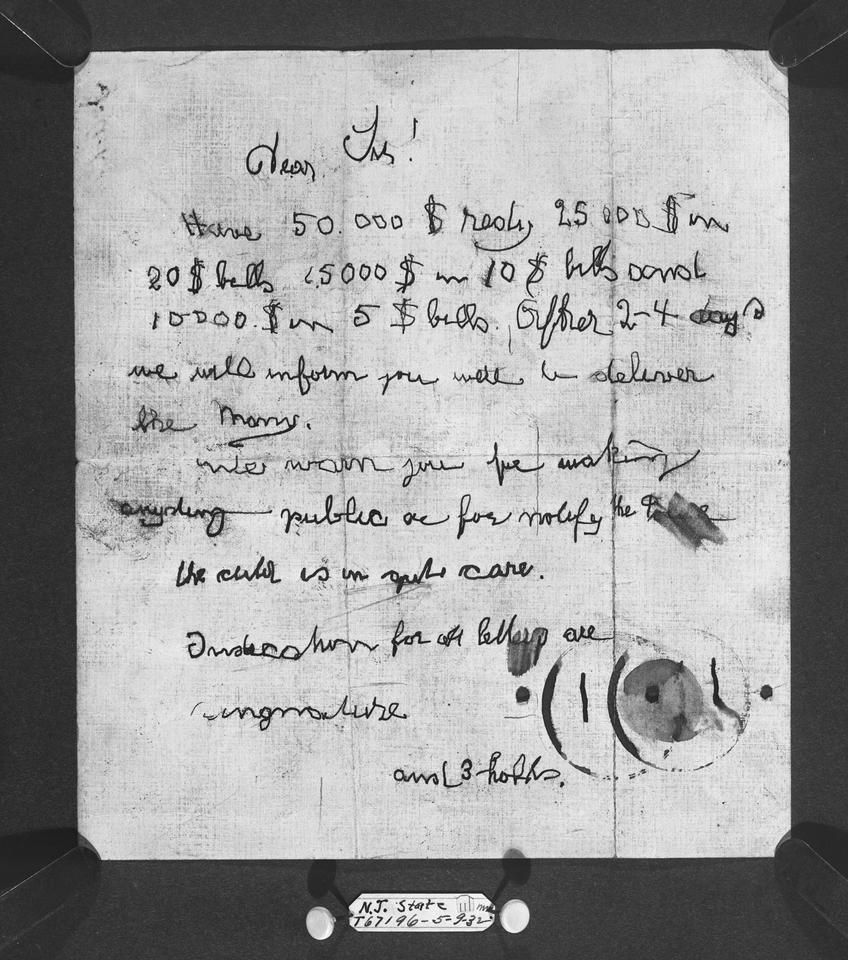
A scan of a glass plate negative of the first note left by the kidnapper in the Lindbergh case. The scan has been reversed to show a positive image of the note. Lieutenant R. A. Snook of the New Jersey State Police, the chief investigator in the Lindberg case, brought this and the other ransom notes to the National Bureau of Standards on May 9, 1932, so Wilmer Souder could examine and photograph them.
While searching through old scientific publications, Butler found that Souder often discussed these very same issues. For instance, in an article by Souder in the March 19, 1932, issue of Army and Navy Journal, Souder discussed the importance of precision measurement in forensic analysis. He also called for minimum standards for laboratory equipment and standards for qualification of experts. In doing so, Souder anticipated with eerie similitude the very issues that are roiling the forensic community today.
So, can we have confidence in Souder’s analysis of Hauptmann’s handwriting? “We don’t have his detailed case notes, so we don’t know exactly how he conducted his analyses,” Butler said. “But in terms of his scientific approach, he was way ahead of his time.”
Souder had no understudies in forensic science, and after he retired in 1954, the National Bureau of Standards no longer involved itself in forensic casework. Souder had maintained a much more visible profile in his dental research, and he would have a great influence on the trajectory of that field. But his contributions to forensic science would be largely forgotten. Today, the forensic community is still grappling with issues that Souder first raised almost 100 years ago.
A Family Connection
Perhaps the biggest piece of this still incomplete puzzle fell into place after Butler searched census records, marriage announcements and genealogy websites to locate Souder’s only living descendant. Kathy Leser is a retired corporate executive living in Lancaster, Pennsylvania, and she bears a striking resemblance to her grandfather.
Leser was unaware how important a role Souder played in the early days of forensic science. Most of her memories of him are from after he retired to Pennsylvania. Butler and Frederick-Frost invited Leser to NIST so they could share what they had found. When she visited, she brought a box of Souder’s belongings from her attic.
The box contained a photo of a young Souder growing up on the family farm in Indiana, and photos of Souder, his wife and daughter—his only child—on vacation in Europe. It contained press clippings and letters of appreciation from FBI director J. Edgar Hoover and Treasury Secretary Andrew Mellon. It also included a gun carry permit that listed as the reason for issuance: “Witness in criminal identifications for Federal & D.C. Governments. Personal protection desirable for such service.”
Leser donated these items to the NIST archive. Frederick-Frost, who originally intended only a museum display about the history of forensic science, mounted an exhibit on Souder which opened at the NIST Museum in June 2016. Today, Frederick-Frost is a curator at the Smithsonian National Museum of American History, where she specializes in the history of science.
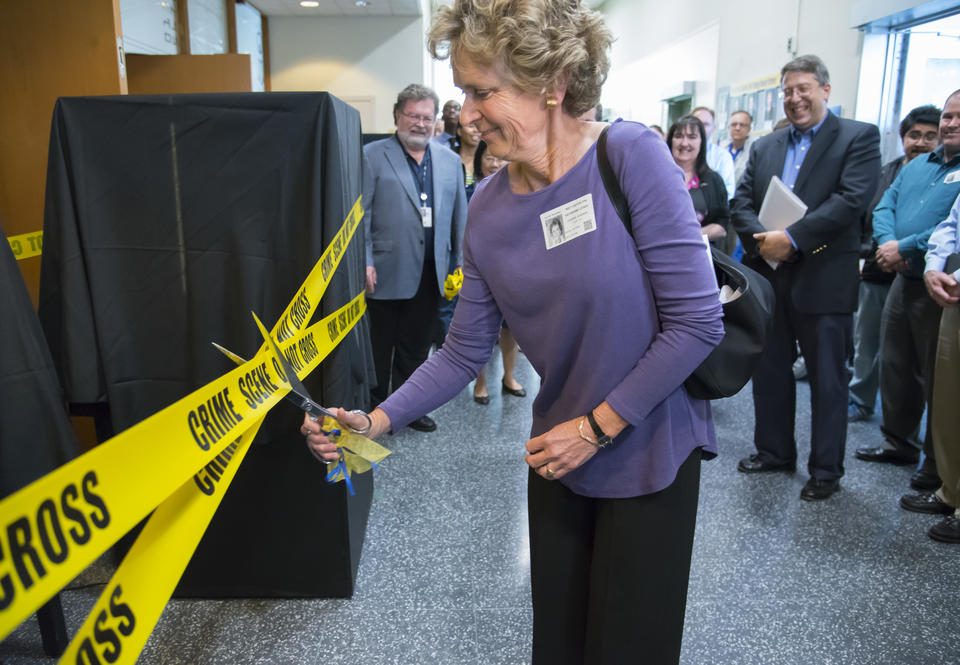
Kathy Leser, Wilmer Souder’s granddaughter, opens an exhibit on Wilmer Souder the NIST Museum on June 10, 2016.
Butler continues his work to move forensic science forward. He has always kept notes on the efforts he’s been involved in, but he does that now more than ever to ensure that an institutional memory of these efforts persists. That way, future efforts can build upon what’s already been accomplished rather than repeating what came before.
Butler and Frederick-Frost both continue to search for information about Souder. There is surely more out there, though much is permanently lost. The first time they met Leser, Butler and Frederick-Frost asked her if she had a notebook or box with the word “Adamson” on it. Leser did not. She said that Souder had kept organized records in his attic, but since he passed away in 1974, they’ve been lost.

